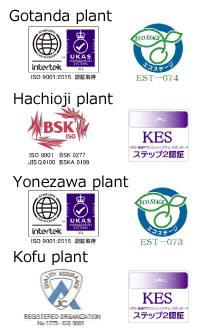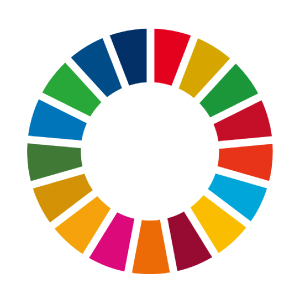Platings > by Substrate
Plating and Finishing by Substrate
Mitsuya has been providing various metal platings & finishings, by our advanced engineering solution on the industrial plating and finishing functional properties. The explanation about the substrate while a plating is listed as follows.
Copper
There are three types of pure copper.
- Tough pitch copper
Most commonly used as a conductive material, 0.02wt% to 0.04wt% oxygen content. The greatest disadvantage (worst weakness) is that tough pitch copper show the hydrogen embrittlement. - Phosphorus deoxidized copper
Produced by treating 1 with deoxidation. This copper does not show the hydrogen embrittlement, but its electrical conductivity is low (85% of 1). - Oxygen-free copper
High purity and absence of deoxidizers, purity is more than 99.95 wt%, some of them is 6N (99.99995wt%). Oxygen free copper has the highest electrical conductivity, highest corrosion resistance and does not show the hydrogen embrittlement.
Mitsuya has the special method for the oxygen-free copper, because it’s surface finishing affects its properties.
Brass
Brass is an alloy made mainly of copper and zinc. The most common composition of the brass is 65wt% copper and 35wt% zinc by weight.
General color becomes faint as the proportion of zinc is increasing, and becomes reddish as the proportion of zinc is reducing.
Brass has the excellent spreadability and ductility, it is used in cold processing such as milling and lathe,
and frequently used as a material of the metal components which require fine cutting.
In order to avoid zinc diffusion on plating layer, copper or nickel is firstly plated on the brass as under layer.
Phosphor Bronze
Phosphor bronze is the alloy containing copper, tin and phosphorous. The phosphor bronze contains tin from 0.5 to 11wt%, and phosphorous from 0.01 to 0.35 wt%.
Phosphor bronze is mainly processed into strip material or plate, is also used as an excellent spring.
During pretreatment the material is easily oxidized and generates tin oxide.
The surface heat-treated for improving spring characteristics is difficult to get the active surface for plating. Mitsuya has the optimum conditions for plating on the phosphor bronze.
Usually, before various surface layer plating, copper or nickel is plated as under layer.
Beryllium Copper
Beryllium copper is the alloy which is added 0.5 to 3wt% beryllium to copper. Since the toxicity of beryllium becomes a problem, usage of this alloy is declining. The strength and durability of the alloy is increased by heat treatment. This alloy is very difficult to be plated, therefore special pretreatment is necessary. Mitsuya has provided good plating with suitable pretreatment for the alloy. Usually, various metals are plated to the alloy since a copper or nickel is plated as under layer.
Titanium Copper
Titanium copper is a special copper alloy with the addition of titanium from 1.0 to 4.0wt% copper.
This alloy has the intensity, the stress relaxation properties and the bending properties same as beryllium copper alloy.
Therefore, this alloy is used mainly in the connector terminals, the battery terminals and burn-in sockets of electronic equipment.
This alloy is a difficult material to be plated, however Mitsuya can plate it without any problem.
Aluminum
Aluminum is used as a light metal. A reinforced aluminum is called duralumin, used in an aircraft material.
The alumina surface tends to form oxidation layer and the oxidation layer progress no further, therefore an alumina keeps the corrosion resistance.
To increase the corrosion resistance, chromate treatment or anodizing (anodic oxide coatings) is carried out.
In case of plating on the aluminum, surface oxide layer is required to remove out. Mitsuya can plate various metals on the aluminum as customer request.
Stainless Steel
Etymology of stainless is ”hard to rust”. Stainless steel (SUS) containing chromium.
The surface oxide layer with chromium rich composition is formed, and the oxide layer keeps corrosion resistance.
When SUS is plated, firstly they remove the oxide layer of the SUS and secondly plate strike-nickel and plate nickel, silver and gold.
Mitsuya can plate directly gold, silver, copper and tin.
Zinc
Zinc is a bluish silver-white metal.
It is used in precision die cast, is easy to rust in the humid circumstance, the surface condition of the metal affects the finish of the plating greatly.
Berwick material of a wear- and abrasion-resistant die -casting zinc is the alloy containing 4wt% aluminum and 4wt% copper.
This is demanded to the special pre-treatment because of difficult material to be plated.
Mitsuya has developed a pre-treatment to obtain a good plating adherence without damaging the material surface.
Magnesium
Magnesium is lighter metal than aluminum. In recent years, Magnesium is used in the laptop computer and smartphone.
It is very easy to be corroded and very difficult to be plated. Mitsuya has succeeded to plate on magnesium materials.
Titanium
Titanium oxide (IV) formed on the surface of the titanium is very strong in corrosion resistances and this metal is particularly difficult to be plated.
Mitsuya has developed special pre-treatment technology and is able to provide a good plating on titanium.
Molybdenum
Molybdenum is white silver and hard high heat-resistant metal. Inside are protected by a robust oxide film in the air.
Molybdenum is a particularly difficult material to be plated.
Mitsuya has developed special pre-treatment for molybdenum, so we have provided good plating on molybdenum metal.
Tungsten
Tungsten has the highest melting point among the metals and is a material with relatively high electrical resistance. This metal is particularly difficult to be plated.
Mitsuya has developed a special pre-treatment for tungsten, so we have provided good plating on this metal including copper tungsten alloy.
Nickel
Color of Nickel is white silver, hard to be rusted in the air and is a material with the corrosion resistance. Nickel is used in the charge terminals of the battery. There are many examples to be plated directly on substrates, and the regulation tends to be made because allergy has been closed up in recent years.
Invar
”Invar” is a kind of alloy, and has the feature that a thermal expansion rate is small.
The etymology of invar is invariable which means "staying the same condition and never changing".
The composition of this alloy is based on iron, and 36wt% of nickel,
and approximately 0.7wt% of manganese and 0.2wt% bellow of carbon are added as a very small amount of ingredient.
Mitsuya has adopted special pre-treatment, and has offered good plating usually apply copper plating as the under layer.
Kovar
Kovar is the alloy which is combined by nickel, cobalt with iron.
The example of the composition is 29% of Ni, 17% of Co, 0.2% of Si, 0.3% of Mn, 53.5% of Fe at a percent by weight.
We can use the special pre-treatment, and can provide good plating on this alloy, usually plate copper as the under layer.
German Silver (Nickel Silver)
German silver (nickel silver) is the alloy comprised of copper, zinc, and nickel.
This is the white silver color alloy which is combined with 50-70wt% of copper, 5-30wt% of nickel and 10-30wt% of zinc.
We can provide plating by standard process.
Alloy 42
Alloy 42 has low thermal expansion coefficient among the metal and the value is close to the hard glass or ceramics.
Because of this, alloy 42 can be used for the electrode material of the electronic component to be sealed glass (lead), and the IC lead frame.
This component of the alloy is 42wt% of nickel, 57wt% of iron, copper, sometimes manganese is added.
The coarsening of crystal grains and excessive annealing cause trouble in case of plating. We have conducted the plating in the usual process.
Hastelloy
Hastelloy is the alloy which has corrosion resistance and heat resistance by adding the molybdenum and chromium based on nickel.
It is a trademark of the company in the United States. Because this alloy group is used widely in the world, the name becomes a general noun in Japan.
Mitsuya has provided the plating on Hastelloy with special pre-treatment.
Die Casting
Die casting is a method that can produce a large volume of product with high dimensional accuracy, by injecting the melted metal in a mold.
The typical materials of die casting are aluminum and the zinc. We can provide the plating on both materials.
Ceramics
In recent years, various kinds of ceramics are made as an electronic component material.
We served the prototyping or mass production plating to the various kinds of the ceramics.
Your inquiries are welcomed. We will apply the optimum pre-treatment for your ceramics.
Carbon
Carbon has the excellent heat radiating characteristics and sliding property. In recent years, the material of (the carbon + aluminum) also has been used as a heat sink. We can provide plating on these materials.
Powder
Prototype request for the functions improvement by plating on the various metal powder and ceramic powder has been increasing.
Please feel free to contact us! Because we have plated metals on various powders.
Silicon Wafer
Silicon wafer is a substrate for fabricating semiconductor devices. We can provide a plating on the wafer with vacuum depositing or sputtering including resist film.
Compound Semiconductor Wafer
Compound semiconductor is a semiconductor which has multiple elements in the material. We have provided a plating for a wafer formed as the sputtered film and resist film and also for a raw wafer directly.
Glass
Glass is a familiar material, on the other hand, it is a difficult to be plated.
Mitsuya can plate metals at several microns on soda-lime glass.
Please let us know if you would like to plate on the quartz glass of high purity!
Plastics
Plastic materials have various types. We can provide a prototype plating for plastic products, however do not have mass production line for plastics-plating. We will produce experimentally as confirming the specifications required by customers. Please inquiry by the contact form first!
Vapor deposition or Sputtering deposition
Mitsuya has provided the plating on various substrates which deposited metal by vapor deposition or sputtering.















